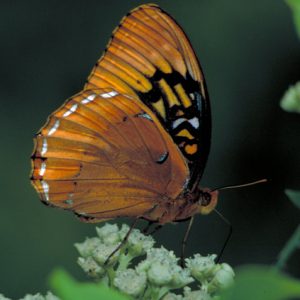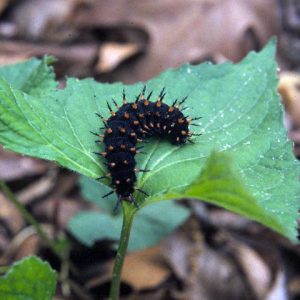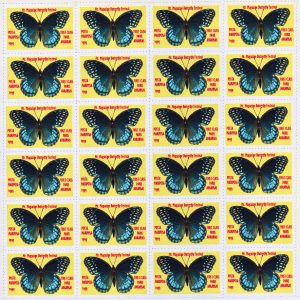calsfoundation@cals.org
Official State Butterfly
aka: Diana Fritillary [Butterfly]
On February 28, 2007, Act 156 of the Arkansas General Assembly designated the Diana fritillary (Speyeria diana) as the official state butterfly. Introduced by Representative John Paul Wells of Logan County, the legislation for making the butterfly a state symbol took note of the butterfly’s beauty, educational importance, and impact on tourism in Arkansas.
Arkansas is the only state to designate the Diana fritillary as its state butterfly, pairing it with its state insect, the honeybee. Arkansas is the twenty-sixth state to designate a butterfly as a state symbol.
The Diana fritillary is among the most spectacular of the 134 resident species of butterflies found in Arkansas. Diana was the Roman goddess of light and life (Artemis in Greek mythology), later known as the goddess of the moon and hunting, and as a protector of women. Fritillary is derived from the Latin word fritillus, meaning “dice-box,” probably referring to spot patterns on the wings. The butterflies are large (3.5″ wingspan) and showy. Males are blackish-brown with orange markings; the larger females are black with iridescent blue. The species was first described in 1777 by Pieter Cramer from a male discovered in Jamestown, Virginia. The female was described in 1864 by W. H. Edwards from the Kanawha and Elk Rivers of West Virginia.
Interest in the Diana fritillary increased in the mid-1990s when entomologists began searching for them throughout the Interior Highlands and discovered their natural habitat was diminishing due to either fire suppression or urban development. They have been identified as a “species of special concern” by the Arkansas Natural Heritage Commission.
Diana fritillaries thrive in moist, mountainous habitats, such as Mount Magazine. It is a relatively long-lived butterfly, with adults living four to five months, increasing citizens’ chances of viewing them. The larval host plants are violets. Adults require high-quality nectar plants.
This butterfly has been recorded in twenty-seven counties in Arkansas and is occasionally observed in the mountains of Oklahoma and Missouri. This represents the “western” United States population; the “eastern” population occurs in the southern Appalachians, including central Virginia, northern Georgia, Tennessee, and Kentucky.
For additional information:
The Diana Project: Saving AR State Butterfly. https://thedianaproject.org/ (accessed May 28, 2024).
Edwards, W. H. “Description of the female Argynnis diana.” Proceedings of the Entomological Society of Philadelphia 3 (1864): 431.
Moran, M. D., and C. D. Baldridge. “Distribution of the Diana Fritillary, Speyeria diana, (Nymphalidae) in Arkansas, with Notes on Nectar Plant and Habitat Preference.” Journal of the Lepidopterists’ Society 56 (Autumn 2002): 162–165.
Opler, Paul, and George Krizek. Butterflies East of the Great Plains. Baltimore, MD: Johns Hopkins University Press, 1984.
Ross, G. N. “Definitive Destination: Mount Magazine State Park, Arkansas.” American Butterflies 6 (Summer 1998): 24–33.
Spencer, Lori A. Arkansas Butterflies and Moths. Little Rock, AR: Ozark Society Foundation, 2006.
Spencer, Lori A., and Don R. Simons. The Diana Fritillary: Arkansas’s State Butterfly. Little Rock: Ozark Society Foundation, 2011.
Ware, David. It’s Official! The Real Stories behind Arkansas’s State Symbols. 2nd ed. Little Rock: Butler Center Books, 2017.
Wells, Carrie N. “Range Collapse, Genetic Differentiation, and Climate Change: An Ecological History of the Diana Fritillary, Speyeria diana, and Projections for Its Future.” PhD diss., Clemson University, 2014.
Lori A. Spencer
Mount Magazine State Park
 Arts, Culture, and Entertainment
Arts, Culture, and Entertainment Diana Fritillary
Diana Fritillary  Diana Fritillary Larva
Diana Fritillary Larva  Male Diana Fritillarys
Male Diana Fritillarys  Official State Butterfly Stamps
Official State Butterfly Stamps 



I saw one in Waldron, Arkansas, during the first and second week of June.
I spotted a male Diana fritillary butterfly on milkweed I had planted for monarchs. I live in a town about 45 miles south of Kansas City. Just wanted to let you know that you are sharing your butterflies with Kansas!